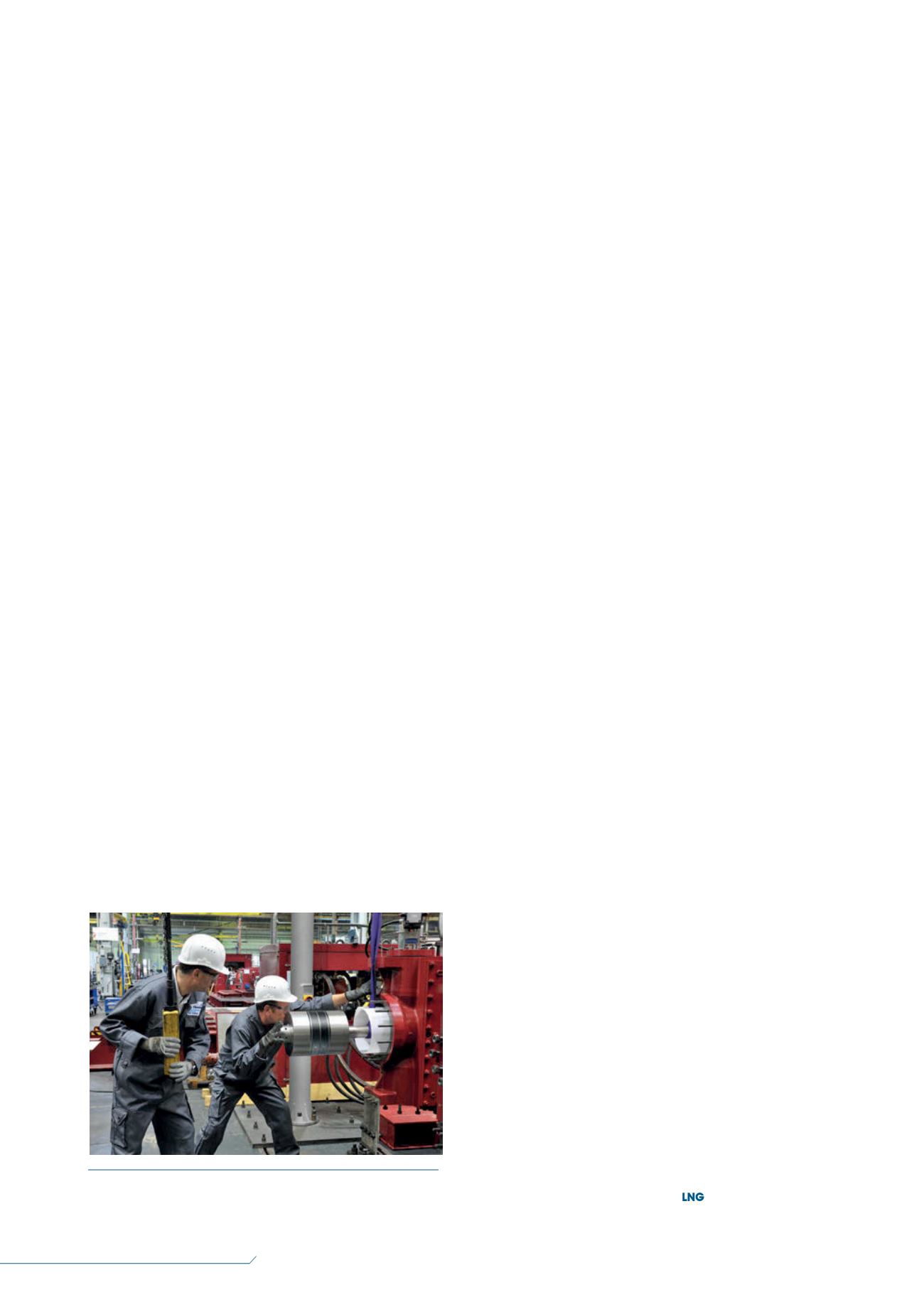
54
LNG
INDUSTRY
APRIL
2016
thin, this gas cushion is completely stable. If the gap
between the rider ring and cylinder liner decreases,
the flow of process gas is reduced, increasing the
pressure in the bearing area, which provides more lift
force and increases the gap. This design ensures correct
performance under all operating conditions.
The process gas supply for the resulting hydrostatic
gas bearing is realised by using the interior of the
hollow compressor piston as a pressurised gas buffer.
During compression stroke, the process gas is fed to the
hydrostatic gas bearing by allowing high pressure gas to
flow into the hollow piston through a check valve,
preventing backflow during the expansion and intake
stroke. The low gas flow through the nozzles ensures
that there is not an appreciable loss of efficiency in the
compressor’s performance.
In situations where the gas bearing is temporarily
unavailable, such as during start-up of the compressor
when no gas is actually compressed in the cylinder, the
FFP functions as a conventional piston, running on the
rider ring surface. As soon as the compressor is loaded
and starts compressing gas, the pressure is built up
within a few strokes and the piston is lifted.
Case study
The FFP has proven itself in the field in a wide variety
of applications. One Howden customer requested
support for a non-Howden three-stage reciprocating
compressor, with a first-stage double-acting cylinder
and the second and third stage combined into a tandem
cylinder design.
Although the reciprocating compressor was working,
the effective lifetime of the piston and rider rings –
especially on the tandem cylinder – was disappointing.
Maintenance records revealed that the MTBM and mean
time between failure (MTBF) was 4000 – 6000 hr. The
short and unpredictable MTBF/MTBM of the compressor
caused a significant loss of production, due to plant
outages. Furthermore, the customer was confronted
with high direct and indirect operating expenses, such
as high spare parts costs, field personnel, damaged
pistons and cylinder liners. Therefore, the customer’s
objective was to eliminate any unscheduled
maintenance and increase the MTBM to 2 years, or
more than 16 000 operating hours.
Solution
Facing a challenging process environment with a highly
corrosive gas and a non-lubricated cylinder, Howden
proposed to apply its FFP technology. Field reverse
engineering activities, as well as intensive discussions
with the customer related to process requirements and
maintenance experience, provided the proper ground
for an innovative and sound design.
After implementation of the technology, the
compressor was running smoothly, with a significant
increase in availability and reliability. The resulting
MTBM exceeded 16 000 hr. The FFP technology can be
applied as retrofit to virtually any horizontal
reciprocating compressor, either in non-lubricated
service, or by converting existing lubricated cylinders to
non-lubricated service.
A significant increase in reliability and availability of
BOG compressors can be achieved by leveraging FFP
technology for non-lubricated compressors (Figure 6).
The benefits of FFP technology include:
Eliminating rider ring wear: by applying FFP
technology, the contact between piston rider rings
and cylinder liners is eliminated during compressor
operation. In this way, unpredictable rider ring wear
in cryogenic, non-lubricated service is avoided.
High compressor efficiency: the leakage across
the double acting piston is significantly less than
for conventional piston and rider rings designs, or
for labyrinth piston designs, as found in vertical
compressors.
Maintenance: the pistons require no special
skills or tools for service and maintenance
operations, while offering long MTBM cycles in
comparison with conventional, non-lubricated
polytetrafluoroethylene (PTFE) based piston and
rider ring designs.
Retrofits: the technology can be retrofitted on
existing reciprocating compressors, irrespective of
brand or type. The impact on the compressor from
such a retrofit is minimal, as the existing piston
rod, piston rod packing and compressor valves can
generally be re-used without any modification.
Conclusion
Reliability is paramount for horizontal reciprocating
compressors operating in BOG or send-out service.
As oil-free compressor cylinders are mandatory for
this application, reducing downtime caused by the
unpredictable wear of rider rings is of crucial importance
in increasing the reliability and availability of these
compressors. Getting to the root cause and eliminating
this wear mechanism altogether by using cutting edge
gas bearing technology, Howden Thomassen’s FFP
prevents unscheduled downtime and extends the
lifetime of rider rings significantly.
Figure 6.
FFP installation during compressor assembly at
Howden Thomassen facilities.


